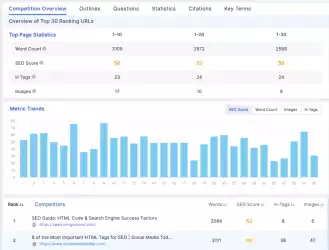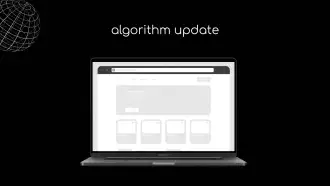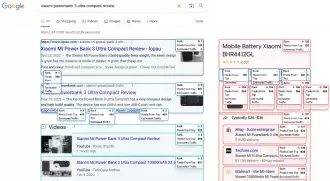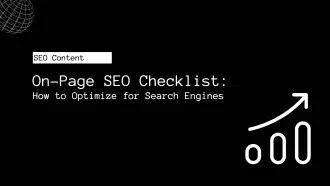These algorithms help search engine results present quality content to searchers and penalize spam. Some of the search engine algorithm Algorithm updates over the years have been quite significant.
One such algorithm update in 2011 was the Google Panda update. This algorithm update was significant because it focused on quality content rather than the number of links.
In this blog post, we’ll tell you everything you need to know about the Google Panda algorithm update 2011 and how you can recover from it if your website got affected by it.
We’ll also tell you some facts about the algorithm update that’ll be worth remembering for next time.
Why Google Created Panda
Back in 2011, search engine giant Google released the Panda algorithm update to help improve search results quality. The update was named after engineer Navneet Panda, who had worked on the algorithm’s development.
The update’s primary goal was to help websites that provide low-quality content get de-indexed from search results. It was also intended to improve user experience by filtering out low-quality sites from appearing high in search engine rankings.
After the update was released, search engine Danny Sullivan dubbed it “Farmer” and stated that a “bidding war” between quality content and low-quality content had started. This led to better-quality content being recognized in search results while low-quality content was no longer favored by search engine algorithms.
After the Penguin update was released one year later, Google added yet another algorithm update named panda which aimed at preventing black hat link building.
In short, if a website is spammy or low-quality, it won’t be able to rank high in search engine rankings. To prevent any backlash from Google, webmasters should perform a link audit and remove backlinks that appear to be spammy or low-quality.
Google Panda Update Launches
In late 2011, Google launched its Panda update to help address websites using bad SEO practices to manipulate search engine results.
The update was named after Navneet Panda, a high-ranking web spammer who was penalized by the search engine giant for his fraudulent activities.
The update became officially part of Google’s core algorithm in January 2016, after years of being integrated into the core algorithm.
The update was designed to improve search engine results by filtering out substandard sites.
As part of the update, low-quality content would be shown low in search rankings, while high-quality content would be given high rankings. This helped to improve the quality of content on search results pages and better reflect the queries’ intent.
In addition to this, penalty rankings were also implemented for high-quality content sites that did not follow best practices.
With Panda on board, search results are more accurate and relevant for users.
What We Know About the Panda Algorithm
The Panda algorithm was created by a Google engineer Biswanath Panda and named “Farmer”. The algorithm was initially released in February 2011 to combat black hat SEO tactics and web spam.
- It affects about 12% of search results in English.
- The algorithm prioritizes user experience and quality of content.
- There have been 28 data updates to the algorithm since its inception. Each update aims to improve ranking quality for high-quality content. The most recent update, known as Panda 4, happened in July 2017.
- It’s important for marketers to stay abreast of these updates to ensure their content is ranking high on search engine results pages (SERPs).
Panda and Google E-A-T:
Google’s introduction of the principles of E-A-T in search quality guidelines in 2014 has played a vital part in the overall quality of content on search engine results pages (SERPs). This focus has been further emphasized in recent years, with updates and core algorithmic changes focusing on the quality of content and the user experience.
Following inputs from search engine experts and users, Google has introduced several updates to Panda, which have focused on content quality. The update to Panda’s algorithm in May-June 2015 emphasizes the importance of content quality by highlighting factors such as originality, high-quality content, and relevant content.
In addition to this update, there have been core algorithmic changes designed to penalize low-quality content. These include changes to keyword ranking algorithms to reduce low-quality queries ranking high, penalizing thin content, as well as removing low-quality websites from search results.
These steps have contributed to improving user experience by providing high-quality content on search engine results pages. With these core algorithmic changes and updates to search quality evaluator guidelines, Google’s approach to E-A-T is becoming increasingly clear.
Google Panda Recovery
– If you’ve been hit by the recent update of Google’s Panda algorithm update, it’s high time you take steps to recover from it. This algorithm update targeted low-quality content on the web, and that includes low-quality content on your website too.
– To begin with, make sure your content is high-quality and unique. Also, focus on keyword optimization for better ranking in search results.
– If nothing else works, start writing quality content that is original and informative. Additionally, update your website content with fresh and updated content to recover from the algorithm update.
Google Panda Myths
– The update was named ‘Panda’ with respect to an engineer, Navneet Panda, who played a key role in the update’s success.
Panda Isn’t About Duplicate Content
Panda is not about duplicate content. Instead, it’s a ranking algorithm designed to identify and penalize web pages that contain content that has been posted elsewhere on the internet. The algorithm looks for content on a webpage that appears on multiple pages of the internet without any significant change in content or quality.
If duplicate content is found, Google will treat it as low-quality content and may lower the ranking of the original webpage containing the original content. This algorithm helps search engine results pages to be more relevant and engaging for users. By removing duplicate content from search results, search engine results pages can provide users with results that are high-quality and unique.
Duplicate content isn’t a negative ranking factor; instead, it’s part of search engine results pages’ efforts to provide users with high-quality results.
Should You Delete Content to Resolve Panda Issues?
Google advises against deleting content to resolve Panda issues. Instead, it recommends adding more high-quality content to your website. This will help your website rank better in search results and attract more traffic. Additionally, ensure that you use a no index tag on pages that contain duplicate content to avoid it appearing in search results. Panda’s algorithm penalizes duplicate content heavily, so this is essential if you want your content to appear high-quality in search results.
Additionally, duplicate content can cause serious issues with the Panda algorithm. To ensure quality content, it’s important to regularly update and maintain your blog and website, including regular posts and quality-focused blog content. This helps Google find high-quality information and ensures that search results are up-to-date and relevant.
Panda & User-Generated Content
The Panda update is designed to target high-quality content sites, so user-generated content sites are not specifically targeted. Instead, low-quality content such as duplicate or low-quality content may be affected. Content produced on high-quality sites may rank better because it will have better user engagement and a higher quality ranking.
However, user-generated content sites should still take steps to ensure quality content is being produced. In particular, search engine experts recommend avoiding spammy guest posts and forums filled with spam to prevent low-quality content from ranking and receiving featured snippets.
Besides, search engine users should be careful about search queries that produce results from user-generated content sites. This can result in duplicate results from user-generated content sites that are already ranking high in search results.
Word Count Isn’t a Factor
Google Panda was created to distinguish between high-quality and low-quality websites by taking other factors into account, including word count.
The update aims to reward websites with substantive and relevant content. It initially affected up to 12% of English-language search results. As Google continues to update its algorithm and refine its ranking algorithm over time, the quality of search results will continue to improve for users.
Word count is not a factor in Google Panda, which instead considers other elements such as content quality and relevance.
By prioritizing high-quality content over keyword-heavy sites, Google Panda helps users find the best search results possible. This update has helped improve search results quality over time, resulting in a better user experience overall.

Affiliate Links & Ads Aren’t Directly Targeted
Google Panda algorithm update does not specifically target affiliate sites, but they can be more often hit by the algorithm. This is because of their low-quality content. If a website has low-quality content, it increases the chances of it being panda-ed.
Panda algorithm update doesn’t target user-generated content in particular and it considers all pages of a website equally high-quality. In other words, quality is more important than dates or fresh content. Thus, if a site has quality content on all pages, then search engine results pages (SERP) will show high-quality results.
However, some steps search engine marketers can take to improve their ranking performance, include creating content with higher quality and updating their search engine optimization strategy accordingly.
Google Panda algorithm explained: how it works
Google Panda is an algorithm that was launched in February 2011 to tackle the falling quality of Google’s search results.
- This algorithm was initially rolled out separately from the core algorithm and then subsequently incorporated into the algorithm in March 2012.
- Its purpose is to provide better rankings for high-quality sites with original content and information.
- The algorithm, which is named after Navneet Panda, first identifies low-quality content on a given website. This content includes low-quality backlinks, low-quality content, thin content, duplicate content, and low-quality headers and titles.
- Next, it calculates a measure of quality based on various factors such as keyword ranking, domain authority, and recent search queries. It then ranks this content of low quality higher than high-quality content.
- As a result of this ranking process, websites with low-quality content are penalized more severely than high-quality sites. Thus these websites will often experience a drop in rankings over time.
Panda is an algorithm applied to sites
Panda is an algorithm used by Google to filter low-quality websites from search engine results pages (SERPs). Panda looks at the quality of a website, assessing content, site architecture, and more. It focuses on identifying content farms – groups of low-quality pages clumped from other websites.
These pages are often duplicate content with little original content or information. Panda looks for sites with original content and information such as research, in-depth reports, and thoughtful analysis. By identifying low-quality content and demoting it from search results, Panda helps improve the user experience while ranking high-quality content higher in search results.
Will remove or improving low-quality content help?
The Google Panda algorithm is a search engine quality algorithm that targets low-quality content in search results. Poorly written content, duplicate content, and copied content can result in a website being penalized by the algorithm.
Google Panda rewards high-quality websites in search results and filters out low-quality websites based on a set of on-site signals. To optimize the potential of content, web developers and content creators must focus on delivering unique, high-quality content. The algorithm targets thin on-site content, duplicate content, and pages with a poor content-to-ad ratio.
To maximize the potential of content, web developers and content creators must focus on delivering the best user experience. By creating high-quality content and implementing quality SEO practices, website owners can better ensure their pages are shown in search results.
Google on how to evaluate whether a site is ‘high-quality’
Google has published a list of 23 questions to help webmasters evaluate whether a site is high-quality. The queries include questions on whether the content is original, accurate, and written by an expert or enthusiast who knows the topic well. Additionally, they should avoid duplicate content and be trustworthy.
By focusing on improving content quality, websites can increase their ranking on Panda updates. To improve their ranking on the algorithm update, sites must focus on quality content and regular SEO-related maintenance.
How to recover from Panda
If you’ve been hit by the Panda algorithm update, you should consult a penalty recovery service to properly recover from this ranking penalty and ensure your content remains visible to the search engine algorithm.
- Users should focus on quality content and unique content rather than keyword stuffing and keyword optimization. When writing content, they should avoid duplicate content and low-quality content.
- They can also use content quality metrics to assess the quality of their content and make sure it is of high quality.
- Users can use keyword research tools to learn about search engine ranking factors and what content is valuable.
- Finally, they can also opt for penalty-free keyword rankings if they are experiencing issues with the Panda algorithm update
- The best thing to do is wait and watch as penalty recovery services have been known to be successful in recovering from ranking penalties.
How can I know if I’ve been hit by Panda?
One of the major indicators of the Google Panda update penalty is a sudden drop in organic search traffic, search engine rankings, or visibility. This may be accompanied by factors such as competitors outranking a website or spam activities leading to penalties.
Consider duplicate content and pages on your website. Look for duplicate Title Tags as a potential indicator of duplicate content. If you find duplicate content on your website, update it with the original content or remove it.
Make sure that your content is unique, high-quality, and relevant to your audience’s search queries. You can do this by making thorough research before writing content and by implementing a quality content strategy.
Also, ensure that you are not obliged under Panda algorithm guidelines. If you have been penalized, consider reviewing your content for duplicate pages or unnecessary pages and update them where needed.
Other facts about the Panda update
– The Panda update was launched in 2011 by Google to address sites using bad SEO methods to manipulate search engine rankings.
– An update to the algorithm was a change to the algorithm, while a refresh meant Google reapplied all the same signals from the most recent update.
– Many websites have been penalized with the Panda update as part of Google’s ongoing effort to improve ranking quality.
– In 2015, an update to the algorithm was launched that addressed low-quality content among other factors in search results. This update, named “Panda,” is still underway. Here are FAQs regarding the Panda update:
-What is the Panda update?
-The Panda update is a change to the algorithm that targets low-quality content on web pages. It was developed in response to concerns over low-quality content continuing to dominate search results.
– When did it launch?
-In March 2012, the update was named after Google staffer Navneet Panda and integrated into the core algorithm.
– What’s behind it?
– The update is intended to tackle low-quality content on web pages such as spam, low-quality content farm pages, content farms, and thin content pages that are ranking high in search engine results.
Google Panda Algorithm
The Panda algorithm update is a core algorithm update created by Google engineer Biswanath Panda in 2011. The update is intended to target low-quality content on web pages and penalize sites with thin content or a high number of low-quality pages.
As the name suggests, it was specifically created to target low-quality content on web pages, ie thin sites or sites with lots of pages containing little original content.
These types of websites are often low-quality and spammy, and they tend to have low page rankings and low search engine rankings. This update affects some major publishers as well, who create content of low quality but still manage to rank high in search engine results pages.
It’s important to note that Panda is an algorithm update, not a ranking factor. It doesn’t impact your search engine ranking or how visible your website appears on the search engine results page.
Some of the major websites that were affected by this algorithm update are Yahoo! Australia, Business Insider, Barstow High School, Craigslist Australia, and more.
Google Penguin Algorithm Update
In April of 2012, Google updated its algorithm to reduce spam on its search engine with the Penguin update. The update targeted pages with too many advertisements and low-quality content. The update targeted pages that had been previously marked as low-quality after a human review process. Penguin was part of an extensive series of updates from Google over the last decade.
Other algorithm updates have included Panda, Hummingbird, Mobile-Friendly, RankBrain, Possum, Google Core, BERT, and Page experience. These algorithm updates have helped improve search results for users by reducing duplicate content, improving user experience, and targeting low-quality content.
However, recovery strategies for sites affected by Penguin include avoiding thin content and content farms, as well as improving user experience to ensure high-quality content on the page.
Sites affected by Penguin may have something wrong with their on-site SEO rather than their backlinks. Penguin primarily looked at content quality rather than quantity when identifying low-quality pages.
So if you are experiencing issues with your search engine results after the update it is most likely due to poor-quality content rather than high-quality links pointing to your site.
Additionally, penguin prioritized low-quality sites over high-quality sites so it’s important to avoid thin content or keyword stuffing to improve search engine results.
Finally, the penguin was a fast update of Google’s search engine algorithm so there may be other factors at play besides poor quality content that needs to be improved upon for search engine results to improve.
Google RankBrain Algorithm Update
Google released RankBrain, an AI-based system, in October 2015 to improve the accuracy of user queries and search results. Panda, also known as the “Farmer” update, was released in February 2011 to punish sites with low-quality content or poor user experience.
The update targets sites with thin content or pages that are mostly links or advertisements. Panda algorithm update initially targeted thin sites and content farms, but now focuses on sites with little original content. The algorithm update was named after Google staffer Navneet Panda who helped develop it.
The update has been successful at improving search results and ranking quality over time and continues to be one of Google’s core ranking algorithms to this day. In addition to the Panda algorithm update, Google has also released updates such as Hummingbird in 2013 and T-Scripts in 2016 to improve search results and ranking quality over time.
These algorithm updates have been instrumental in ranking search results more relevant to user queries and increasing user engagement on search results pages.
Frequently Asked Questions
What is the Google Panda algorithm update?
The Google Panda algorithm update was introduced in 2011 to reward high-quality websites and reduce the amount of web spam in organic search results. It was originally designed to target sites with thin content or content farms. The update was rolled out separately from the core algorithm but was integrated into it in March 2012.
Google named the algorithm update after Navneet Panda, a staffer who worked on the project. The algorithm update became part of Google’s core algorithm in January 2016.
What are the key changes that took place with the Google Panda algorithm update?
The Google Panda algorithm update was designed to limit the visibility of low-quality content on search engine results pages (SERP). The update penalizes sites with advertising or other quality-related issues and refreshes the algorithm frequently to improve results.
With the enhancements of Panda update 4.0, websites that have made improvements to their content may escape the filter altogether.
Panda was introduced in 2011 to eradicate or diminish low-quality search results. Originally, the algorithm was designed to help Google “notice and reward high-quality content throughout all of its web search results”.
Over time, the algorithm has been refined to better handle user queries and make better judgments about ranking quality.
What are the possible benefits of implementing an SEO strategy in light of the Google Panda algorithm update?
When it comes to the Google Panda algorithm update, implementing a search engine optimization strategy can have a lot of benefits for your website.
Here are just some of them:
SEO can help websites achieve higher rankings on SERPs, potentially driving more organic traffic.
SEO can help websites identify and optimize high-quality content, which can positively impact search engine rankings.
SEO helps websites eliminate “thin” content, keyword stuffing, and grammatical/factual errors, improving user experience.
SEO can help websites optimize UX, allowing them to achieve high rankings and maximize potential.
SEO can help websites adjust to a continuous optimization process, promoting quality content.
Conclusion
If you’ve been hit by Panda, don’t panic. The update is designed to ensure quality content is ranking high in search results. While it’s difficult to predict whether your content will be penalized, there are certain things you can do to improve the quality of your content and user experience that may help keep you out of trouble.
Implementing user-generated content guidelines, for example, will help you create high-quality content. Likewise, ensuring quality links and keyword-rich content will boost rankings. You can also try keyword stuffing and quality content strategy to increase search engine ranking.



